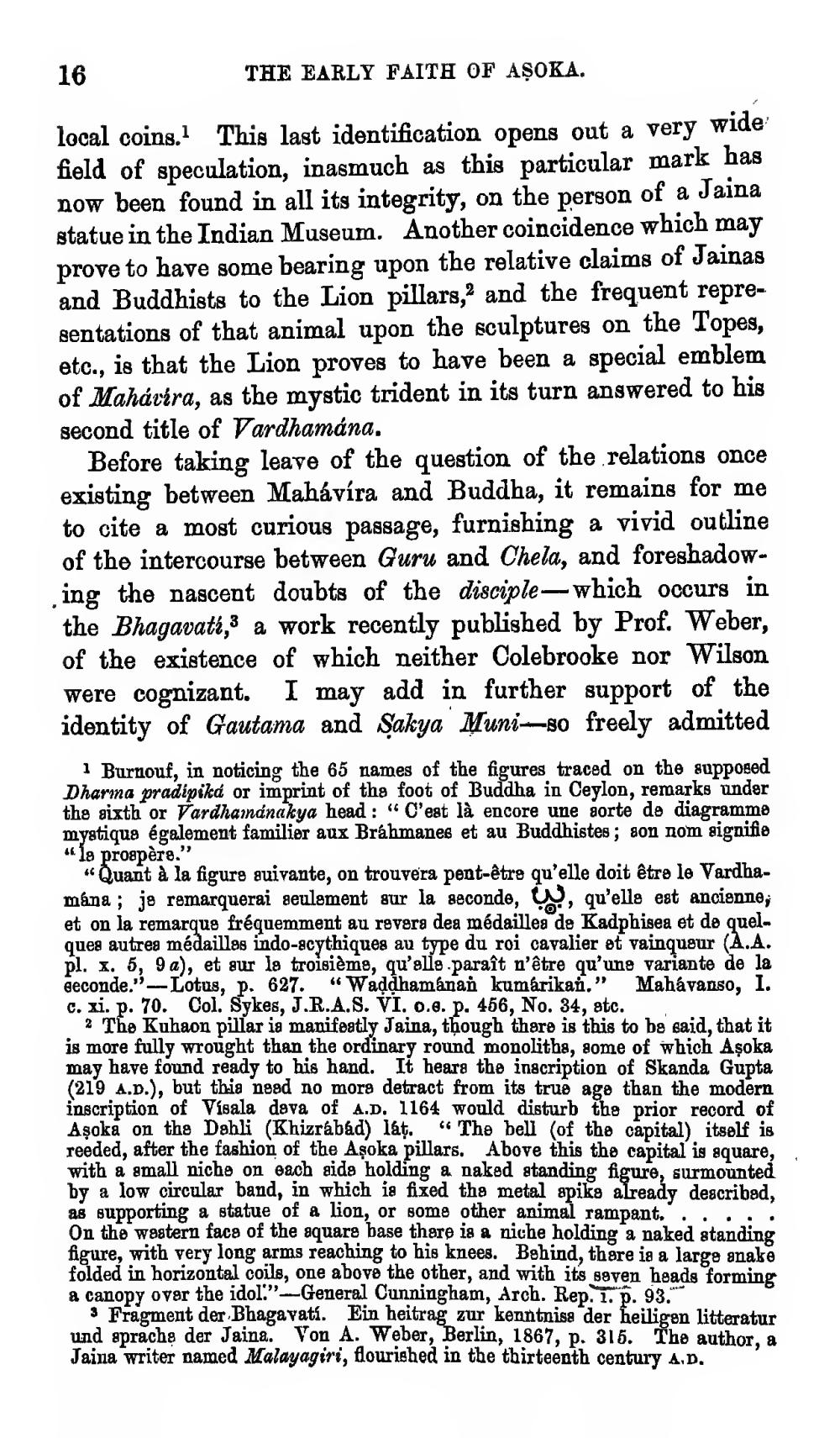________________
16
THE EARLY FAITH OF AŞOKA.
local coins. This last identification opens out a very wide field of speculation, inasmuch as this particular mark has now been found in all its integrity, on the person of a Jaina statue in the Indian Museum. Another coincidence which may prove to have some bearing upon the relative claims of Jainas and Buddhists to the Lion pillars, and the frequent representations of that animal upon the sculptures on the Topes, etc., is that the Lion proves to have been a special emblem of Maharira, as the mystic trident in its turn answered to his second title of Vardhamána.
Before taking leave of the question of the relations once existing between Mahávíra and Buddha, it remains for me to cite a most curious passage, furnishing a vivid outline of the intercourse between Guru and Chela, and foreshadowing the nascent doubts of the disciple— which occurs in the Bhagavati, 3 a work recently published by Prof. Weber, of the existence of which neither Colebrooke nor Wilson were cognizant. I may add in further support of the identity of Gautama and Şakya Muni~so freely admitted
1 Burnouf, in noticing the 65 names of the figures traced on the supposed Dharma pradipiká or imprint of the foot of Buddha in Ceylon, remarks under the sixth or Vardhaiánakya head : " C'est là encore une sorte de diagramme mystique également familier aux Brahmanes et au Buddhistes; son nom signifio "lo prospère."
"Quant à la figure suivante, on trouvera pent-être qu'elle doit être le Vardhamána ; je remarquerai seulement sur la seconde, w., qu'elle est ancienne; et on la remarque fréquemment au revera dea médailles de Kadphisea et de quelques autres médailles indo-acythiques au type du roi cavalier at vainqueur (A.A. pl. x. 5, 9a), et sur la troisième, qu'ello paraît n'être qu'une variante de la @econde." -Lotus, p. 627. “Waddhamanan kumarikan.” Mahávanso, I. c. xi. p. 70. Col. Sykes, J.R.A.S. VI. o.e. p. 456, No. 34, atc.
2 The Kuhaon pillar ia manifestly Jaina, though there is this to be said, that it is more fully wrought than the ordinary round monoliths, some of which Asoka may have found ready to his hand. It hears the inscription of Skanda Gupta (219 a.p.), but this need no more detract from its true age than the modern inscription of Vísala dova of A.D. 1164 would disturb the prior record of Aşoka on the Dehli (Khizrabad) láţ. “The bell (of the capital) itself is reeded, after the fashion of the Aşoka pillars. Above this the capital is square, with a small niche on each sids holding a naked standing figure, surmounted by a low circular band, in which is fixed the metal spiks already described, 99 supporting a statue of a lion, or some other animal rampant.... On the western face of the aquare base there is a niche holding a naked standing figure, with very long arms reaching to his knees. Behind, there is a large anake folded in horizontal coils, one above the other, and with its søven heads forming a canopy over the idol!" --General Cunningham, Arch. Rep. 1. p. 93.*
3 Fragment der Bhagavatí. Ein heitrag zur kenntniss der heiligen litteratur und sprache der Jaina. Von A. Weber, Berlin, 1867, p. 316. The author, a Jaina writer named Malayagiri, flourished in the thirteenth century A.D.




